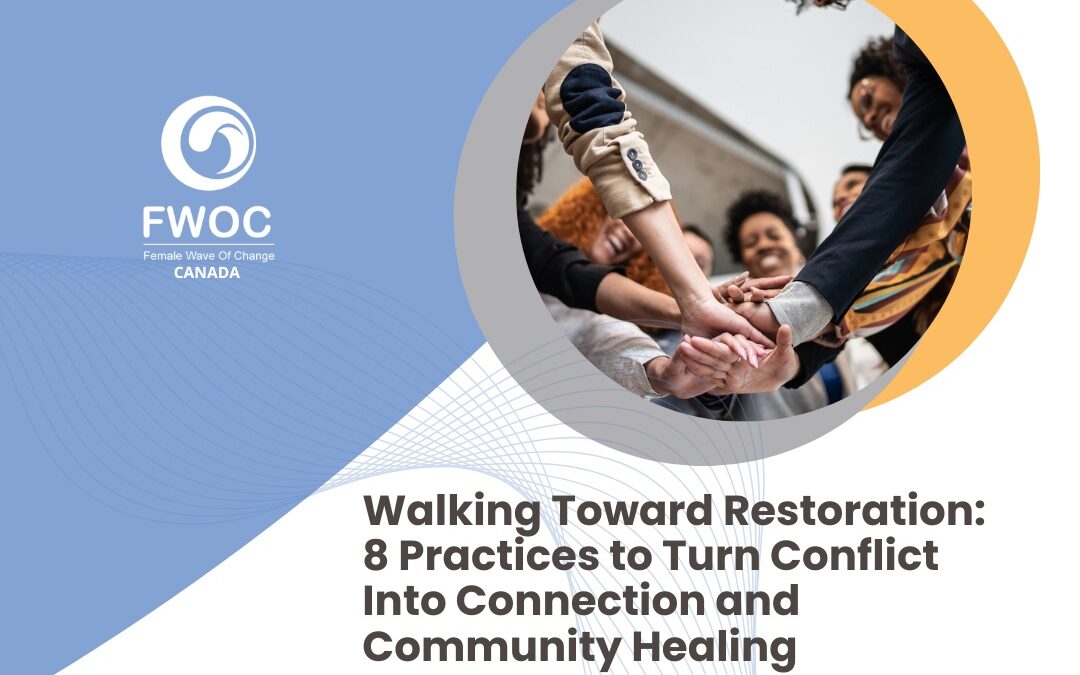Walking Toward Restoration: 8 Practices to Turn Conflict Into Connection and Community Healing
By Ame-Lia Tamburrini
In leadership, entrepreneurship, and even family life, when conflict arises, many of us instinctively reach for control: shutting down conversations, ending partnerships, or avoiding difficult truths. These responses mirror the systems we inherited — systems that prioritized order, hierarchy, and punishment over healing and wholeness.
But women know: relationships are the real infrastructure of business and life. What if there’s another way? A way rooted not in punishment, but in restoration. A way that invites truth, repair, and deeper relationship.
Understanding the Colonial Roots of Punishment
Colonial systems disrupted Indigenous ways of being—ways that understood community as interconnected, where conflict was not isolated or individual, but communal and relational. Colonization imposed top-down legal and organizational structures that stripped away context, severed relationships, and displaced spiritual accountability with bureaucratic authority.
For women business owners and leaders, understanding these roots matters because we often carry the double weight of navigating patriarchal and colonial systems while trying to build enterprises rooted in care and connection. This legacy remains embedded in modern organizations, where we often prioritize compliance over compassion, and “efficiency” over empathy.
If we truly care about reconciliation—not just as a national or regional narrative, but as a lived, daily practice—we must revisit how we respond to harm. Not just in the criminal justice system (we desperately need to revisit that), but in the boardroom, the family business, the community meeting, and across the Zoom screen.
My Connection With Restorative Justice
After my parents divorced, I lived with my grandmother who was a beacon of compassion. Our home became a gathering place for the Alcoholics Anonymous community. Men would sit around her kitchen table where she served coffee, cookies, and pie, listening deeply to their stories. She never judged either of her husbands who were part of that circle. Instead, she embraced the support systems that helped them heal. She ingrained in me that everyone deserves to be heard, to be given a second chance, and to be served an oatmeal cookie.
When I was about 20, one of my uncles was convicted of a crime. I watched in confusion as family members cut him out of their lives in the name of love for those he harmed—without ever asking why. Why did he show up the way he did? I could understand the anger and hurt, but I couldn’t understand how one minute we could love someone and the next label them evil and abandon them. I watched my grandmother grapple with this too. At the end of the day, she chose connection over exile.
Unbeknownst to me, these experiences shaped who I became and the work I am most passionate about. When I moved to Victoria in 2016 and discovered the Restorative Justice Victoria program, I started training as a facilitator and have been taking cases since 2018. It is the work that most meaningfully reminds me how respect, accountability, and care can lift someone out of their darkest moment and bring them back to wholeness.
True leadership, as my grandmother showed me, is not about control — it’s about compassion. That same wisdom now informs how I support women leaders, entrepreneurs, and retired changemakers in navigating conflict with dignity and courage.
What Is Restorative Justice in Business and Leadership?
Restorative justice is not merely a process; it’s a paradigm shift.
At its core, restorative justice is an approach to addressing harm that centres healing, accountability, and the restoration of relationships—rather than punishment or blame. It invites all those impacted by a conflict or wrongdoing to come together, share their experiences, and collaboratively determine a path forward that meets the needs of everyone involved.
In business and leadership, this means we stop treating conflict as a problem and begin to see it as an opportunity:
- An opportunity to understand harm,
- To repair trust,
- And to strengthen the fabric of our teams, partnerships, and communities.
It asks:
- Who has been harmed?
- What do they need?
- Whose obligation is it to meet those needs?
- How do we restore relationship—not just fix the behaviour?
Restorative justice doesn’t just resolve issues—it transforms culture.
You may be asking, “Well, how do you actually do that, Ame-Lia?” Great question. Especially because it’s easy to get caught up in the weight of “the system” and believe there’s nothing you can do.
But here’s the truth: you are the system. If you change, so does it. Brilliant, yes?
Here are some practices you can start to implement right away, even if nothing around you changes.
8 Principles to Practice Daily
1. Prioritize Harm Over Rules
Instead of asking, “What rule was broken?” ask, “Who was harmed and how?” This re-centres the humanity in your leadership.
- Example: Instead of saying, “They missed a deadline,” consider, “How did this impact trust, revenue, or client relationships? What support would rebuild accountability?”
2. Include All Voices
Healing happens through inclusion, not exclusion. Invite both those affected and those responsible into the conversation.
- Example: In a conflict with a business partner, create a facilitated dialogue where both can express impact and intent, and co-create a plan for repair. (Caution: preparation matters—don’t jump into dialogue if people aren’t ready.)
3. Support Without Shaming
Accountability doesn’t require humiliation. Encourage reflection, responsibility, and growth without diminishing dignity.
- Example: Replace public call-outs with private, compassionate conversations that invite learning and personal responsibility.
4. Dialogue as a First Response
Before jumping to policies, the legal system or severing ties, create space for conversation.
- Example: Before escalating a board dispute or legal matter, offer a restorative conversation centred on understanding and reparation.
5. Empower the Community
Train teams, boards, or families in conflict navigation. Restorative tools belong to everyone, not just leaders.
- Example: Train staff or volunteers in peer listening, emotional intelligence, and circle dialogue. Normalize check-ins and shared responsibility for culture.
6. Make Agreements Achievable
Commitments should be realistic, not punitive.
- Example: Instead of an impossible turnaround, co-create a timeline that supports growth and accountability at a manageable pace.
7. Acknowledge Unintended Consequences
Reflect on how your structures may unintentionally perpetuate harm.
- Example: A policy requiring in-person meetings may exclude women advisors who are retired or caregiving. Ask: “How might we adapt to include them?”
8. Reintegrate, Don’t Isolate
After harm occurs, the goal is restoration, not exile.
- Example: After a tough moment with a family member or volunteer, welcome them back by inviting them to share what they’ve learned and how they want to contribute going forward. Offer mentorship, not just warnings.
Walking the Path of Reconciliation
If we want businesses, organizations, and communities that are truly inclusive, safe, and just, we must recognize that conflict is not a detour from the work, it is the work. Conflict is where values are tested, relationships are revealed, and healing becomes possible.
Restorative justice asks us to slow down, listen deeply, and lead with humility. It asks us to recognize the historical traumas that shaped our systems and to commit, one interaction at a time, to walking in a different direction.
This is not just leadership. It is stewardship. It is the quiet, sacred work of tending to our shared humanity. It is the wisdom of Indigenous and relational cultures around the world. Let it guide you.
If you need more rationale: this work has opened me to so much more self-compassion. And I know, from working with countless women leaders, entrepreneurs, and retired changemakers—we could all use more of that.
Reflection
Ask yourself this with curiosity, not judgment:
Where in my business, my leadership, or even in how I treat myself, am I upholding systems of punishment when I could be cultivating restoration?

